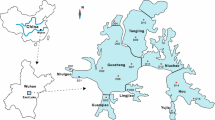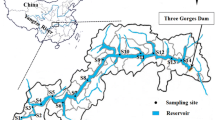Abstract
Concentrations of six phenolic endocrine-disrupting chemicals [4-tert-octylphenol (OP), 4-t-nonylphenol (4-t-NP), 4-n-nonylphenol (4-n-NP), nonylphenol mono- to di-ethoxylates (NP1EO, NP2EO), and bisphenol A (BPA)] and five estrogens [estrone (E1), β-estradiol (E2), estriol (E3) 17α-ethynylestradiol (EE2), and diethylstilbestrol (DES)] were determined in surface water and sediment samples collected from the Songhua River in northeast China. Concentrations of sum of five alkylphenols and alkylphenol ethoxylates (ΣOP, 4-n-NP, 4-t-NP, NP1EO, NP2EO) were 117–1,030 ng L−1 (mean 296) in water samples and 25.5–386 ng g−1 (mean 67.3 ng g−1 dry weight (dw)) in sediments. Concentrations of BPA in water and sediments were 8.24–263 ng L−1 (mean 52.0) and 1.60–17.3 ng g−1 dw (mean 4.90 dw), respectively. Concentrations in water were 0.840–20.8 ng L−1 (mean 5.03) for the sum of three natural steroidal estrogens (ΣE1, E2, E3) and below detection limit (BDL) at −1.38 ng L−1 (average 0.200) for the sum of two synthetic estrogens (EE2, ΣDES). Among estrogens, only E1 was detected in all of the sediment samples in the range of 0.100–3.00 ng g−1 dw. Concentrations of Σphenolic EDCs and Σestrogens in water and sediments and their correlations with total organic carbon indicated that these contaminants originate from similar sources, such as municipal wastewater. In situ \(\log K_{oc}^{\prime }\) values and sediment–water fugacity fraction were calculated for the target chemicals, and the results indicated that these chemicals were, in general, supersaturated in sediments relative to those in water.





Similar content being viewed by others
References
Andersen H, Siegrist H, Halling-Sorensen B, Ternes TA (2003) Fate of estrogens in a municipal sewage treatment plant. Environ Sci Technol 37:4021–4026
Arcand-Hoy LD, Nimrod AC, Benson WH (1998) Endocrine-modulating substances in the environment: estrogenic effects of pharmaceutical products. Int J Toxicol 17:139–158
Brennan SJ, Brougham CA, Roche JJ, Fogarty AM (2006) Multi-generation effects of four selected environmental oestrogens on Daphnia magna. Chemosphere 64:49–55
Carballa M, Fink G, Omil F et al (2008) Determination of the solid–water distribution coefficient (K-d) for pharmaceuticals, estrogens and musk fragrances in digested sludge. Water Res 42:287–295
Cargouet M, Perdiz D, Mouatassim-Souali A, Tamisier-Karolak S, Levi Y (2004) Assessment of river contamination by estrogenic compounds in Paris area (France). Sci Total Environ 324:55–66
Chen B, Duan J, Mai B et al (2006) Distribution of alkylphenols in the Pearl River Delta and adjacent northern South China Sea, China. Chemosphere 63:652–661
Chen C, Wen T, Wang G, Cheng H, Lin Y, Lien G (2007) Determining estrogenic steroids in Taipei waters and removal in drinking water treatment using high-flow solid-phase extraction and liquid chromatography/tandem mass spectrometry. Sci Total Environ 378:352–365
Colborn T, Saal FS, Soto AM (1993) Developmental effects of endocrine-disrupting chemicals in wildlife and humans. Environ Health Perspect 101:378–384
Duong CN, Ra JS, Cho J et al (2010) Estrogenic chemicals and estrogenicity in river waters of South Korea and seven Asian countries. Chemosphere 78:286–293
Ferguson PL, Charles RI, Brownawell BJ (2001) Distribution and fate of neutral alkylphenol ethoxylate metabolites in a sewage-impacted urban estuary. Environ Sci Technol 35:2428–2435
Giesy JP, Hilscherova K, Jones PD, Kannan K, Machala M (2002) Cell bioassays for detections of aryl hydrocarbon (AhR) and estrogen receptor (ER) mediated activity in environmental samples. Mar Pollut Bull 45:3–16
Gobas FAPC, Maclean LG (2003) Sediment–water distribution of organic contaminants in aquatic ecosystems: the role of organic carbon mineralization. Environ Sci Technol 37:735–741
Harner T, Bidleman TF, Jantunen LMM, Mackay D (2001) Soil–air exchange model of persistent pesticides in the United States cotton belt. Environ Toxicol Chem 20:1612–1621
Heemken OP, Reincke H, Stachel B, Theobald N (2001) The occurrence of xenoestrogens in the Elbe River and the North Sea. Chemosphere 45:245–259
Holbrook RD, Love NG, Novak JT (2004) Sorption of 17β-estradiol and 17α-ethinylestradiol by colloidal organic carbon derived from biological wastewater treatment systems. Environ Sci Technol 38:3322–3329
Hu J, Zhang H, Chang H (2005) Improved method for analyzing estrogens in water by liquid chromatography–electrospray mass spectrometry. J Chromatogr A 1070:221–224
Isobe T, Nishiyama H, Nakashima A et al (2001) Distribution and behavior of nonylphenol, octylphenol and nonylphenol monoethoxylate in Tokyo metropolitan area: their association with aquatic particles and sediment distributions. Environ Sci Technol 35:1041–1049
Isobe T, Serizawa S, Horiguchi T et al (2006) Horizontal distribution of steroid estrogens in surface sediments in Tokyo Bay. Environ Pollut 144:632–638
Johnson AC, White C, Besien TJ, Jurgens MD (1998) The sorption potential of octylphenol, a xenobiotic oestrogen, to suspended and bed-sediments collected from industrial and rural reaches of three English rivers. Sci Total Environ 210(211):271–282
Kawaguchi M, Ishii Y, Sakui N, Okanouchi N, Ito R, Inoue K et al (2004) Stir bar sorptive extraction with in situ derivatization and thermal desorption-gas chromatography–mass spectrometry in the multi-shot mode for determination of estrogens in river water samples. J Chromatogr A 1049:1–8
Khanal SK, Xie B, Thompson ML, Sung SW et al (2006) Fate, transport, and biodegradation of natural estrogens in the environment and engineered systems. Environ Sci Technol 40:6537–6546
Kuch HM, Ballschmiter K (2001) Determination of endocrine-disrupting phenolic compounds and estrogens in surface and drinking water by HRGC-(NCI)-MS in the pictogram per liter range. Environ Sci Technol 35:3201–3206
Labadie P, Budzinski H (2005) Determination of steroidal hormone profiles along the Jalle d’Eysines River (near Bordeaux, France). Environ Sci Technol 39:5113–5120
Lai KM, Johnson KL, Scrimshaw MD, Lester JN (2000) Binding of waterborne steroid estrogens to solid phase in river and estuarine systems. Environ Sci Technol 34:3890–3894
Lei B, Huang S, Zhou Y (2009) Levels of six estrogens in water and sediment from three rivers in Tianjin area, China. Chemosphere 76:36–42
Li Y, Harner T, Liu LY et al (2010) Polychlorinated biphenyls in global air and surface soil: distribution, air–soil exchange, and fraction effect. Environ Sci Technol 44:2784–2790
Loos R, Hanke G, Umlauf G et al (2007) LC-MS-MS analysis and occurrence of octyl- and nonylphenol, their ethoxylates and their carboxylates in Belgian and Italian textile industry, waste water treatment plant effluents and surface waters. Chemosphere 66:690–699
Patrolecco L, Capri S, De Angelis S et al (2006) Partition of nonylphenol and related compounds among different aquatic compartments in Tiber River (central Italy). Water Air Soil Pollut 172:151–166
Peng X, Wang Z, Yang C, Chen F, Mai B (2006) Simultaneous determination of endocrine-disrupting phenols and steroid estrogens in sediment by gas chromatography–mass spectrometry. J Chromatogr A 1116:51–56
Pojana G, Gomiero A, Jonker N, Marcomini A (2007) Natural and synthetic endocrine disrupting compounds (EDCs) in water, sediment and biota of a coastal lagoon. Environ Int 33:929–936
Qi H, Liu L, Jia H, Li Y, Ren N et al (2010) Dechlorane plus in surficial water and sediment in a Northeastern Chinese River. Environ Sci Technol 44:2305–2308
Ren N, Sverko E, Li Y, Zhang Z, Harner T, Jia H et al (2008) Levels and isomer profiles of dechlorane plus in Chinese air. Environ Sci Technol 42:6476–6480
Tashiro Y, Takemura A, Fujii H, Takahira K, Nakanishi Y (2003) Livestock wastes as a source of estrogens and their effects on wildlife of Manko tidal flat, Okinawa. Mar Pollut Bull 47:143–147
Ternes TA, Stumpf M, Mueller J, Haberer K, Wilken RD, Servos M (1999) Behavior and occurrence of estrogens in municipal sewage treatment plants-I. Investigations in Germany, Canada and Brazil. Sci Total Environ 225:81–90
Williams RJ, Johnson AC, Smith JJL, Kanda R (2003) Steroid estrogens profiles along river stretches arising from sewage treatment works discharges. Environ Sci Technol 37:1744–1750
Zhang Z, Hibberd A, Zhou J (2006) Optimization of derivatization for the analysis of estrogenic compounds in water by solid-phase extraction gas chromatography-mass spectrometry. Anal Chim Acta 577:52–61
Zhang Z, Hibberd A, Zhou J (2008) Analysis of emerging contaminants in sewage effluent and river water: comparison between spot and passive sampling. Anal Chim Acta 607:37–44
Zhang X, Li Q, Li G, Wang Z, Yan C (2009) Levels of estrogenic compounds in Xianmen Bay sediment, China. Mar Pollut Bull 58:1210–1216
Zhang Z, Qi H, Ren N, Li Y, Gao D, Kannan K (2011) Survey of cyclic and linear siloxanes in sediment from the Songhua River and in sewage sludge from wastewater treatment plants, Northeastern China. Arch Environ Contam Toxicol 60:204–211
Zhou J, Liu R, Wilding A, Hibberd A (2007) Sorption of selected endocrine disrupting chemicals to different aquatic colloids. Environ Sci Technol 41:206–213
Acknowledgments
We are grateful for financial support from the National Natural Science Foundation of China (Grants No. 21207026 and 21107020) and the Shanghai Tongji Gao Tingyao Environmental Science and Technology Development Foundation.
Author information
Authors and Affiliations
Corresponding authors
Electronic supplementary material
Below is the link to the electronic supplementary material.
Rights and permissions
About this article
Cite this article
Zhang, Z., Ren, N., Kannan, K. et al. Occurrence of Endocrine-Disrupting Phenols and Estrogens in Water and Sediment of the Songhua River, Northeastern China. Arch Environ Contam Toxicol 66, 361–369 (2014). https://doi.org/10.1007/s00244-014-9998-5
Received:
Accepted:
Published:
Issue Date:
DOI: https://doi.org/10.1007/s00244-014-9998-5




